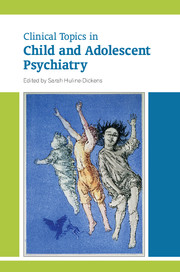Book contents
- Frontmatter
- Contents
- List of tables
- List of boxes
- List of figures
- List of contributors
- Preface
- 1 Child psychiatry and the people who have shaped it
- 2 Fabrication and induction of illness in children
- 3 Personality disorders as disorganisation of attachment and affect regulation
- 4 Post-traumatic stress disorder and attachment: possible links with borderline personality disorder
- 5 Management of antisocial behaviour in childhood
- 6 Pharmacology for attention-deficit hyperactivity disorder, Tourette syndrome and autism spectrum disorder
- 7 Pharmacology for anxiety and obsessive–compulsive disorders, affective disorders and schizophrenia
- 8 Pharmacological management of core and comorbid symptoms in autism spectrum disorder
- 9 Pharmacological treatment of depression and bipolar disorder
- 10 Cognitive–behavioural therapy with children, young people and families: from individual to systemic therapy
- 11 Anxiety disorders
- 12 Somatising: clinical presentations and aetiological factors
- 13 Somatising: management and outcomes
- 14 Evaluating psychological treatments for children with autism
- 15 Attention-deficit hyperactivity disorder: assessment and treatment
- 16 Schizophrenia
- 17 Tourette syndrome
- 18 Sleep disorders
- 19 Self-harm in adolescents
- 20 Adolescent substance misuse: an update on behaviours and treatments
- 21 Eating disorders
- 22 Gender dysphoria in young people
- 23 The psychiatry of children aged 0–4
- Index
3 - Personality disorders as disorganisation of attachment and affect regulation
Published online by Cambridge University Press: 02 January 2018
- Frontmatter
- Contents
- List of tables
- List of boxes
- List of figures
- List of contributors
- Preface
- 1 Child psychiatry and the people who have shaped it
- 2 Fabrication and induction of illness in children
- 3 Personality disorders as disorganisation of attachment and affect regulation
- 4 Post-traumatic stress disorder and attachment: possible links with borderline personality disorder
- 5 Management of antisocial behaviour in childhood
- 6 Pharmacology for attention-deficit hyperactivity disorder, Tourette syndrome and autism spectrum disorder
- 7 Pharmacology for anxiety and obsessive–compulsive disorders, affective disorders and schizophrenia
- 8 Pharmacological management of core and comorbid symptoms in autism spectrum disorder
- 9 Pharmacological treatment of depression and bipolar disorder
- 10 Cognitive–behavioural therapy with children, young people and families: from individual to systemic therapy
- 11 Anxiety disorders
- 12 Somatising: clinical presentations and aetiological factors
- 13 Somatising: management and outcomes
- 14 Evaluating psychological treatments for children with autism
- 15 Attention-deficit hyperactivity disorder: assessment and treatment
- 16 Schizophrenia
- 17 Tourette syndrome
- 18 Sleep disorders
- 19 Self-harm in adolescents
- 20 Adolescent substance misuse: an update on behaviours and treatments
- 21 Eating disorders
- 22 Gender dysphoria in young people
- 23 The psychiatry of children aged 0–4
- Index
Summary
Personality disorders are common psychiatric disorders that carry significant costs for healthcare services. People with personality disorders present a problem in psychiatry because they demonstrate both symptoms of psychological distress and social rule-breaking behaviour. They therefore invite punitive as well as therapeutic responses, which can lead to confusion and negativity among service providers (Watts & Morgan, 1994).
Personality disorders are developmental conditions that begin in childhood and adolescence. Research into gene–environment interactions indicates that the caregiving environment influences the expression of genetic neuropharmacological vulnerability. For example, a hostile caregiving environment makes antisocial behaviour much more likely in boys with variations in allele length for serotonergic proteins compared with those without this mutation (Livesley et al, 1993; Caspi et al, 2002; Kim et al, 2009).
In this chapter, we suggest that the major feature of personality disorders is a failure of affect regulation. We present evidence on the neurobiology of affect regulation and on its development within attachment relationships in a heuristic model that explains both the symptoms of and effective treatment strategies for personality disorders. Being heuristic in nature, this model will, we hope, form the basis of further empirical research. Emotions and affects are essentially similar terms and we use them interchangeably.
Affects
What are they and where are they formed?
Emotion indicates a departure from a basic state of calm (Freeman, 1999: p. 124). Damasio's (1994) view is that emotions are bodily experiences (somatosensory states) in response to external and internal influences. Several areas of the somatosensory cortex are associated with the recall of emotional experiences, especially the insula, cingulate cortex, hypothalamus and several nuclei of the brain-stem tegmentum (Damasio, 2003). The bodily states created include autonomic, neuroendocrine and somatomotor responses that are subjectively experienced as feelings and are expressed through a range of somatomotor responses, including facial, gestural, vocal and behavioural reactions. Thus, behaviour is merely one expression of an affective state; individuals also use words (written and spoken) and facial expression to communicate them.
What are their functions?
Affects act as a driving force or catalyst to assist humans in pursuit of goaldirected behaviours that help us find sources of energy, fend off external noxious agents, and make and maintain social relationships to support a life-sustaining homeostasis (Panksepp, 1998).
- Type
- Chapter
- Information
- Clinical Topics in Child and Adolescent Psychiatry , pp. 26 - 40Publisher: Royal College of PsychiatristsPrint publication year: 2014



